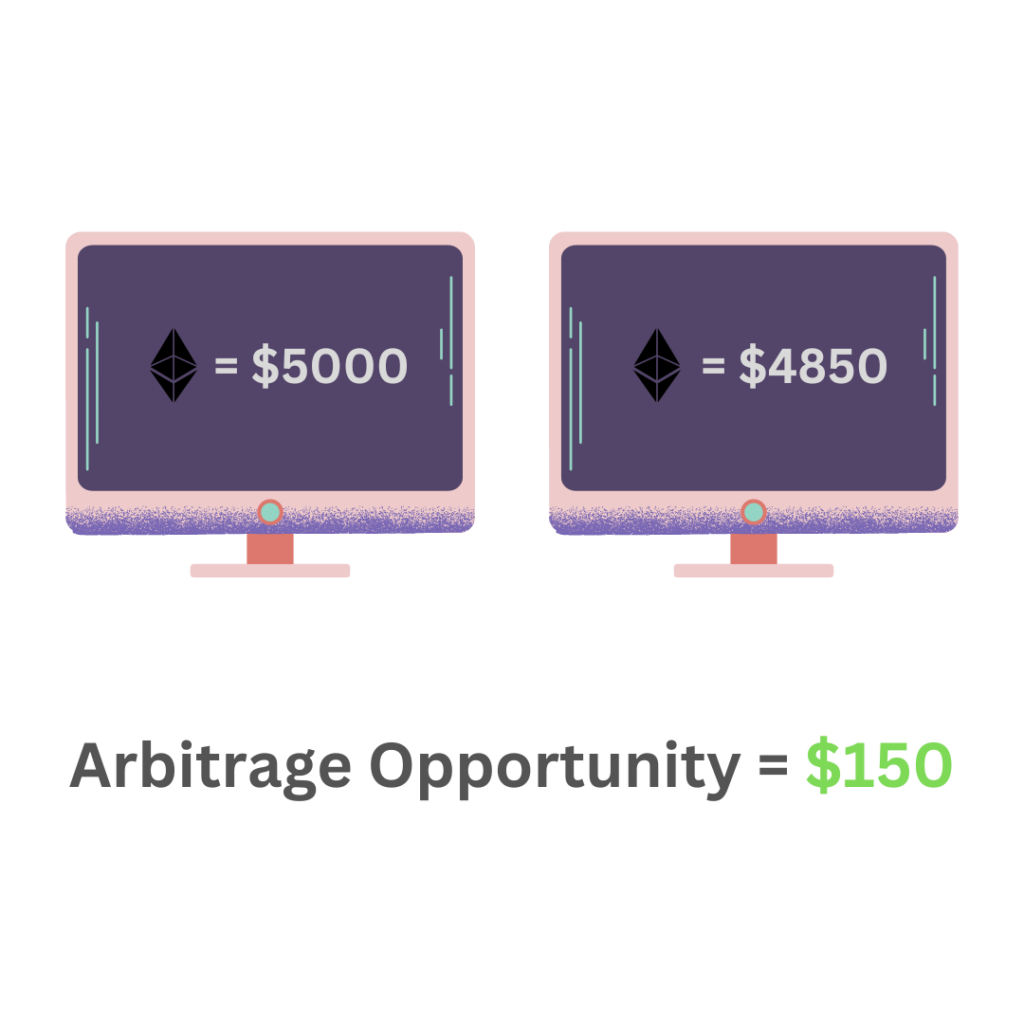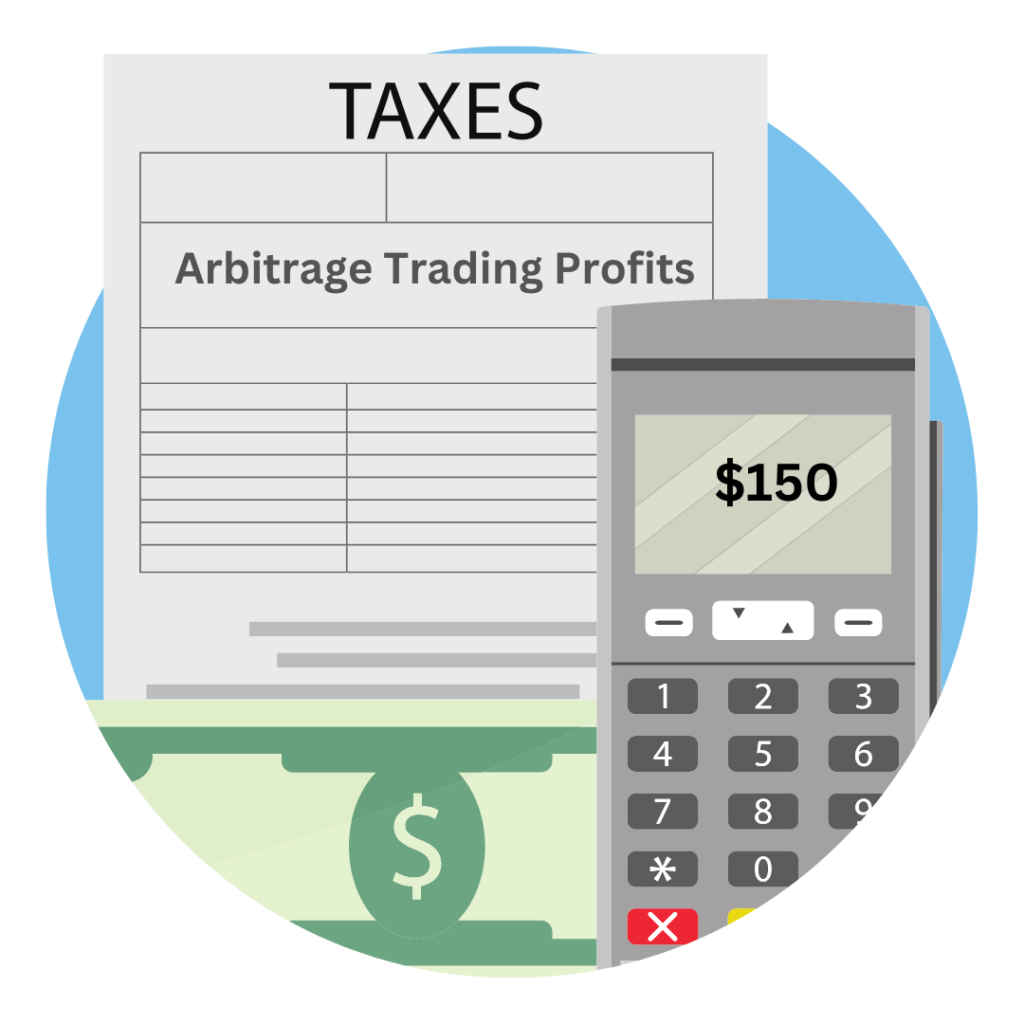Crypto Arbitrage Trading: An In-Depth Guide
Crypto arbitrage trading is low-risk compared to other, more popular trading strategies like day trading or swing trading, mainly because, unlike them, arbitrage trading doesn’t require you to rely on predictive analysis and speculations to make a profit.
Whether the prices rise or fall, you’re almost guaranteed to make a profit with arbitrage trading, assuming you do most things right.
This makes arbitrage trading an ideal option for those who don’t want to learn technical analysis and its complex nuances but still want to trade and earn money from crypto.
However, it’s not a “risk-free” strategy by any stretch. Just as any other trading method, it also has its risks and drawbacks, which we’ll discuss in this guide.
What is Crypto Arbitrage Trading?

Crypto arbitrage trading is when you exploit the price differences of the same cryptocurrency among different exchanges.
It’s not a new concept, yet more popular in the crypto space.
Why?
Because crypto is far more volatile than stocks or securities plus, they are traded on hundreds of different crypto exchanges 24/7, which is not the case with more traditional financial instruments.
Here’s an example of a crypto arbitrage trade –
Suppose Ethereum is selling for $5000 on, let’s say, Coinbase and $4850 on Kraken.
In a situation like this, an arbitrage trader would buy Ethereum from Kraken and instantaneously sell it on Coinbase, exploiting the price discrepancy between the two exchanges to make a profit of $150.
The price differences are usually not this big, though. Most arbitrage traders make small but frequent profits. Sometimes, they add up to something substantial. Sometimes they don’t. But the upside is the low-risk nature of these trades.
Plus, the example is just one of many ways of executing an arbitrage trade.
Different Crypto Arbitrage Trading Strategies
Cross-exchange Arbitrage
This is the most basic crypto arbitrage trading method. You buy a cryptocurrency for less price from one exchange and sell it for slightly higher on another, making a profit.
The example we mentioned in the previous section is a cross-exchange arbitrage trade.
Spatial Arbitrage
This is when you exploit the geographical price difference of cryptocurrencies among different countries.
So, for example, let’s say Bitcoin is selling for $23,900 on an exchange in the United States and $23,850 in India. Now, you have an arbitrage opportunity to make a $50 profit.
DEX Arbitrage
To understand how decentralized arbitrage trading works, first, you must understand how automated market makers work.
We have a complete guide on automated market makers that you can check out. But for the purposes of this article, here’s a brief summary –
In a decentralized protocol, AMM is the system used to price cryptocurrencies in a trading pair and facilitate trades.
Most protocols adopt the constant product formula (𝑥 x y = k) to price their crypto assets. In this formula, 𝑥 and y denote the total units in each asset, while k denotes their product. And k is always constant.
For example, in a trading pair of 200 ETH and 20,000 USDT, the constant (k) will be 4,000,000. So, if someone wants to buy 2 ETH, they must add the required number of USDT to balance the ratio and maintain the constant.
This means no matter what the market price of Ethereum is out there, its price inside the liquidity pool will be determined by its ratio to the other asset.
This imbalance in market price and price inside a liquidity pool creates an arbitrage opportunity for traders to capitalize on.
Bots & Software
As you can imagine, manually finding price discrepancies in different crypto exchanges is not just time-consuming and ineffective but also almost impossible to scale.
And as we mentioned before, profits from arbitrage trading are small. Without scaling the process, it’s almost impossible to earn anything substantial from it.
The following bots and software automate this process and your preferred trading methods using algorithms –
Check out our complete list of best crypto trading bots for more.
Triangular Arbitrage
This strategy is a little more complex than the others. One that is used by advanced traders and requires bots and software to execute successfully. The idea is that you create a trading loop between three (or more) cryptocurrencies, exploiting the price discrepancies between them.
Here’s an example –
First, you trade ETH for SOL (where SOL is undervalued compared to ETH). Then, you trade SOL for BTC (where BTC is overvalued compared to ETH). Finally, you circle back and trade BTC for ETH, completing the loop and incurring a profit.
Risks & Drawbacks of Arbitrage Trading
As we said before, crypto arbitrage trading is not without any risks. The following are the drawbacks and risks of arbitrage trading you should know before stepping into it.
Fees & Costs
Buying and selling cryptocurrencies on exchanges attract transfer fees (and other costs). These costs can quickly add up and eat into your profits. Sometimes, to a point where you lose more than you gain.
However, there are some ways to counter this problem that we’ll discuss in the next section.
Timing
Timing is the most crucial factor to succeed in arbitrage trading. You’re not the only one trying to capitalize on a particular arbitrage opportunity.
Probably hundreds and thousands of others are doing it too. So, you got to be fast, and you got to be early. Sometimes, even a delay of a few seconds can cause the prices to fluctuate, resulting in a loss.
Other than your competition, there are a couple of other obstacles in your way.
Firstly, the Bitcoin blockchain. Any transaction on the Bitcoin blockchain takes anywhere from ten minutes to an hour. During this period, prices can move against you. That’s why many traders avoid Bitcoin and instead trade other cryptocurrencies with faster blockchains like Ethereum.
Secondly, it’s not uncommon for crypto exchanges to go offline for several reasons, like maintenance and server issues. This can pose a significant risk and potentially ruin your arbitrage trading strategy.
However, as we said, we’ll discuss strategies to tackle some of these challenges in the next section.
Hacks & Frauds
Buying and selling cryptocurrencies from different crypto exchanges, sometimes some unpopular ones is a part of crypto arbitrage trading. But unfortunately, it also exposes you to potential hacks and frauds.
The less credible exchanges typically have weaker security, exposing them to hacks and, as a result, exposing you to hacks.
The most recent such attack happened in 2020 to KuCoin, draining over $240 million from their exchange, even though KuCoin is actually one of the more credible platforms.
And that’s only the hacks. Some exchanges are organized exit scams and rug pulls created to steal users’ funds.
Crypto Arbitrage Trading Best Practices
What you learned so far is the theory of crypto arbitrage trading. You only learned how it works on paper. The following are some of the best practices used by seasoned traders that take theoretical knowledge and put it into practical use.
Trading Without Transferring
Most crypto arbitrage traders add funds to different exchanges in advance to reduce transfer fees and other costs and eliminate any risk of losing money due to timing.
This allows them to complete two trades simultaneously instead of first buying a cryptocurrency from one exchange, transferring to another and then selling it.
So, let’s take the first example we mentioned at the start of this article. In this case, the trader will already have 4850 USDT in Kraken to buy and 1 ETH in Coinbase to sell. The trader will then complete both transactions simultaneously, resulting in the same profit but with reduced fees and no risk of delay.
Use Bots
Bots are an essential part of any form of trading. They make the entire process of finding arbitrage opportunities extremely easy. Even though using bots doesn’t guarantee you profits or that you won’t have to do anything, not using them is like trying to chop a tree trunk with a kitchen knife.
Choose Less Popular Cryptocurrencies
How do price differences occur? They occur because of the asymmetry in bid-ask orders through different crypto exchanges.
Most popular cryptocurrencies like Bitcoin and Ethereum have high trading volumes, meaning they are less vulnerable to this asymmetry in price.
However, that’s not the case with the less popular cryptocurrencies. Since they have low trading volume, their prices are more likely to vary from exchange to exchange. That’s why less popular cryptocurrencies are better for arbitrage trading.
Taxes on Crypto Arbitrage Trading

In most countries, crypto gains incurred from selling, swapping or spending crypto are taxed under capital gains, though some countries impose income taxes.
In the US, you must pay capital gain tax rates on your crypto gains.
You must also report all your crypto transactions on your tax return, whether you made a profit or not. As you can imagine, for day traders and arbitrage traders, this becomes practically impossible without a crypto tax tool like Bitcoin.Tax.
So, if you’re considering doing arbitrage trading or any trading, for that matter, reporting and paying taxes can become a huge pain in the back.
Check out our Crypto Tax Guides section to learn how crypto taxes work in your country.